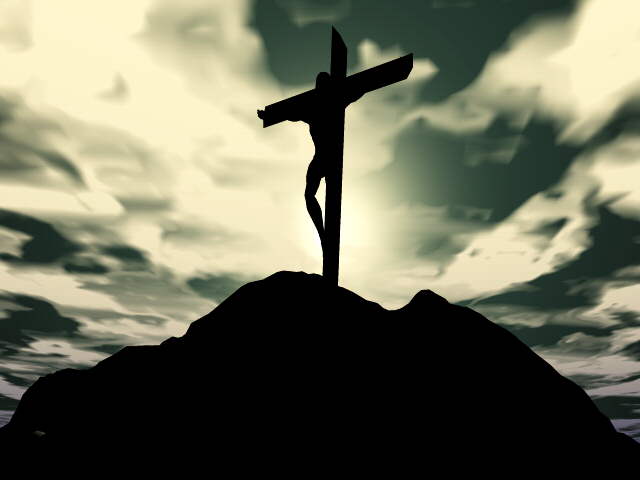فَخَرَجَ وَهُوَ حَامِلٌ صَلِيبَهُ إِلَى الْمَوْضِعِ الَّذِي يُقَالُ لَهُ «مَوْضِعُ الْجُمْجُمَةِ» وَيُقَالُ لَهُ بِالْعِبْرَانِيَّةِ جُلْجُثَةُ
حَيْثُ صَلَبُوهُ، وَصَلَبُوا اثْنَيْنِ آخَرَيْنِ مَعَهُ مِنْ هُنَا وَمِنْ هُنَا، وَيَسُوعُ فِي الْوَسْطِ
وَكَتَبَ بِيلاَطُسُ عُنْوَانًا وَوَضَعَهُ عَلَى الصَّلِيبِ. وَكَانَ مَكْتُوبًا: يَسُوعُ النَّاصِرِيُّ مَلِكُ الْيَهُودِ
فَقَرَأَ هذَا الْعُنْوَانَ كَثِيرُونَ مِنَ الْيَهُودِ، لأَنَّ الْمَكَانَ الَّذِي صُلِبَ فِيهِ يَسُوعُ كَانَ قَرِيبًا مِنَ الْمَدِينَةِ. وَكَانَ مَكْتُوبًا بِالْعِبْرَانِيَّةِ وَالْيُونَانِيَّةِ وَالّلاَتِينِيَّةِ
فَقَالَ رُؤَسَاءُ كَهَنَةِ الْيَهُودِ لِبِيلاَطُسَ: لاَ تَكْتُبْ: مَلِكُ الْيَهُودِ، بَلْ: إِنَّ ذَاكَ قَالَ: أَنَا مَلِكُ الْيَهُودِ
أَجَابَ بِيلاَطُسُ: مَا كَتَبْتُ قَدْ كَتَبْتُ
ثُمَّ إِنَّ الْعَسْكَرَ لَمَّا كَانُوا قَدْ صَلَبُوا يَسُوعَ، أَخَذُوا ثِيَابَهُ وَجَعَلُوهَا أَرْبَعَةَ أَقْسَامٍ، لِكُلِّ عَسْكَرِيٍّ قِسْمًا. وَأَخَذُوا الْقَمِيصَ أَيْضًا. وَكَانَ الْقَمِيصُ بِغَيْرِ خِيَاطَةٍ، مَنْسُوجًا كُلُّهُ مِنْ فَوْقُ
فَقَالَ بَعْضُهُمْ لِبَعْضٍ: «لاَ نَشُقُّهُ، بَلْ نَقْتَرِعُ عَلَيْهِ لِمَنْ يَكُونُ». لِيَتِمَّ الْكِتَابُ الْقَائِلُ: «اقْتَسَمُوا ثِيَابِي بَيْنَهُمْ، وَعَلَى لِبَاسِي أَلْقَوْا قُرْعَةً». هذَا فَعَلَهُ الْعَسْكَرُ
وَكَانَتْ وَاقِفَاتٍ عِنْدَ صَلِيبِ يَسُوعَ، أُمُّهُ، وَأُخْتُ أُمِّهِ مَرْيَمُ زَوْجَةُ كِلُوبَا، وَمَرْيَمُ الْمَجْدَلِيَّةُ
فَلَمَّا رَأَى يَسُوعُ أُمَّهُ، وَالتِّلْمِيذَ الَّذِي كَانَ يُحِبُّهُ وَاقِفًا، قَالَ لأُمِّهِ: يَا امْرَأَةُ، هُوَذَا ابْنُكِ
ثُمَّ قَالَ لِلتِّلْمِيذِ: «هُوَذَا أُمُّكَ». وَمِنْ تِلْكَ السَّاعَةِ أَخَذَهَا التِّلْمِيذُ إِلَى خَاصَّتِهِ
بَعْدَ هذَا رَأَى يَسُوعُ أَنَّ كُلَّ شَيْءٍ قَدْ كَمَلَ، فَلِكَيْ يَتِمَّ الْكِتَابُ قَالَ: أَنَا عَطْشَانُ
وَكَانَ إِنَاءٌ مَوْضُوعًا مَمْلُوًّا خَلاً، فَمَلأُوا إِسْفِنْجَةً مِنَ الْخَلِّ، وَوَضَعُوهَا عَلَى زُوفَا وَقَدَّمُوهَا إِلَى فَمِهِ
فَلَمَّا أَخَذَ يَسُوعُ الْخَلَّ قَالَ: «قَدْ أُكْمِلَ». وَنَكَّسَ رَأْسَهُ وَأَسْلَمَ الرُّوحَ
Carrying his own cross, he went out to the place of the Skull (which in Aramaic is called Golgotha). There they crucified him, and with him two others—one on each side and Jesus in the middle.
Pilate had a notice prepared and fastened to the cross. It read: Jesus of Nazareth, the king of the Jews. Many of the Jews read this sign, for the place where Jesus was crucified was near the city, and the sign was written in Aramaic, Latin and Greek. The chief priests of the Jews protested to Pilate, “Do not write ‘The King of the Jews,’ but that this man claimed to be king of the Jews.”
Pilate answered, “What I have written, I have written.”
When the soldiers crucified Jesus, they took his clothes, dividing them into four shares, one for each of them, with the undergarment remaining. This garment was seamless, woven in one piece from top to bottom.
“Let’s not tear it,” they said to one another. “Let’s decide by lot who will get it.”
This happened that the scripture might be fulfilled that said,
“They divided my clothes among them
and cast lots for my garment.”
So this is what the soldiers did.
Near the cross of Jesus stood his mother, his mother’s sister, Mary the wife of Clopas, and Mary Magdalene. When Jesus saw his mother there, and the disciple whom he loved standing nearby, he said to her, “Woman, here is your son,” and to the disciple, “Here is your mother.” From that time on, this disciple took her into his home.
Later, knowing that everything had now been finished, and so that Scripture would be fulfilled, Jesus said, “I am thirsty.” A jar of wine vinegar was there, so they soaked a sponge in it, put the sponge on a stalk of the hyssop plant, and lifted it to Jesus’ lips. When he had received the drink, Jesus said, “It is finished.” With that, he bowed his head and gave up his spirit.
